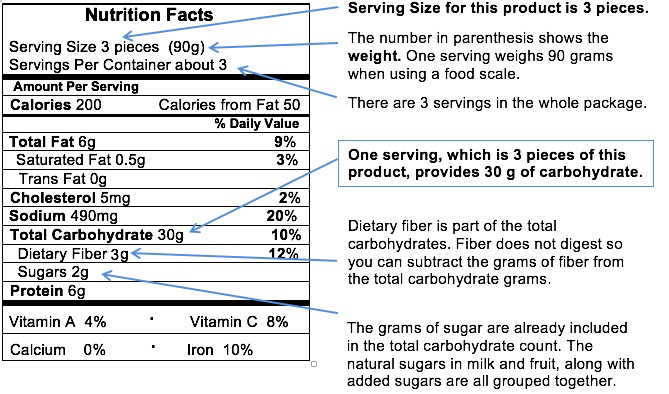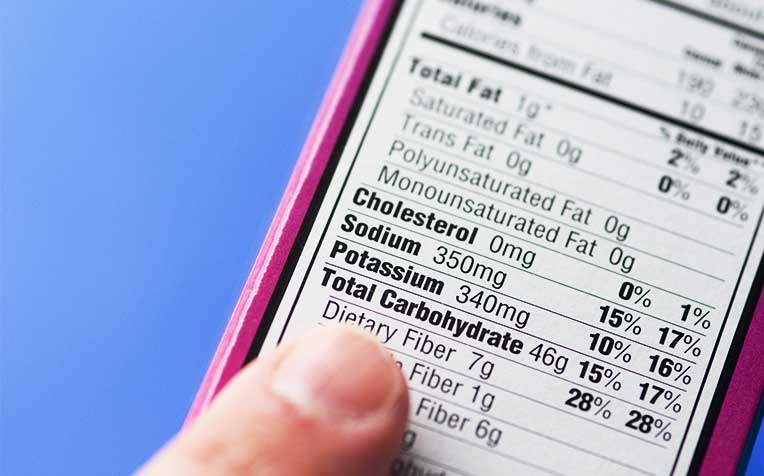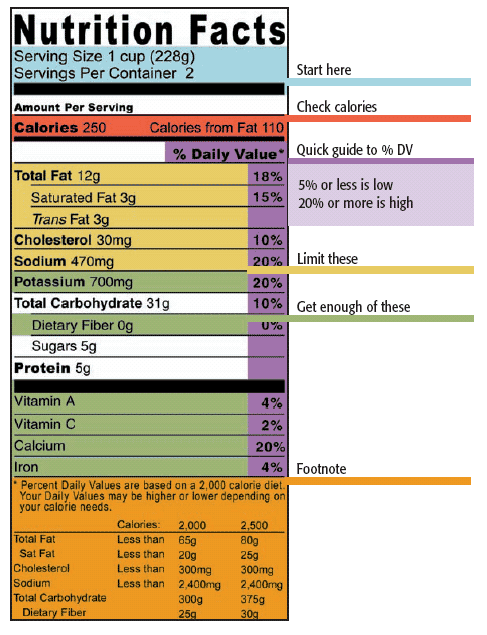42 reading food labels diabetes
Learning To Read Labels :: Diabetes Education Online On a nutrition food label, subtract the fiber from the total carbohydrate amount. When you read food labels, the grams of sugar are already included in the total carbohydrate amount, so you do not need to count this sugar amount separately. The grams of sugar listed include both natural sugars, from fruit or milk, and added sugars. Food Labels and How to Read Them - Diabetesnet.com For those with diabetes, food labels are extremely helpful for carb counting and for determining appropriate insulin doses for these foods. What consumers get from food labels: nutrition information about almost every food in the grocery store; an easy-to-read format that enable consumers to more quickly find the information they need to make ...
› diseases-conditions › diabetesDiabetes - Diagnosis and treatment - Mayo Clinic Aug 09, 2022 · A reading of more than 200 mg/dL (11.1 mmol/L) after two hours means you have diabetes. A reading between 140 and 199 mg/dL (7.8 mmol/L and 11.0 mmol/L) means you have prediabetes. If your provider thinks you may have type 1 diabetes, they may test your urine to look for the presence of ketones.
Reading food labels diabetes
Reading Food Labels When You Have Diabetes | HealthLink BC A food is considered low in saturated fat if it has 5% or less of the daily value. A food is considered high in saturated fat if it has 15% or more of the daily value. Cholesterol is listed below the fats on the food label. Aim to eat less than a total of 300 mg of cholesterol a day. Saturated fat, trans fat, and cholesterol increase your risk ... Reading labels | Diabetes UK Key points Always look at the 'total carbohydrate' on the label when carb counting. This will make sure you are counting both the complex (starchy) and simple (sugary) carbs in your food. Both will raise your blood glucose (blood sugar) levels, and need to be matched with insulin. PDF TO CARE 4 YOURSELF READING A NUTRITION FACTS LABEL - novoMEDLINK Reading the label can help you compare the amount of sodium in different foods so that you can choose lower-sodium options. Talk with your diabetes care team about what to include in your meal plan. Reading a Nutrition Facts label Reference: 1. American Diabetes Association. Standards of medical care in diabetes—2019.
Reading food labels diabetes. › 145476 › diab_labelsReading food labels - Queensland Health Reading food labels . Understanding how to read food labels can help you make healthy food choices. Food Standards Australia and New Zealand (FSANZ) regulates food labelling in Australia. Most packaged food and drink must have a nutrition information panel. Exceptions include those in very small packages, some baked products and take-away food ... How to read food labels if I have diabetes or prediabetes? Knowing how to read food labels is a very useful skill to improve your eating and better manage or help to prevent the progression of diabetes. There are three main things on the food labels to look out for: nutrition information panel, ingredient list, and Healthier Choice Symbols. 1. Nutrition information panel (NIP) Reading Food Labels When You Have Diabetes | Kaiser Permanente Start with the "% Daily Value" column on the food label. A food is considered low in a specific nutrient (such as fat, saturated fat, carbohydrate, or sodium) if it has 5% or less of the daily value. A food is considered high in that nutrient if it has 20% or more of the daily value. Watch out for health claims on food labels. Decoding Diabetes: How to Read Nutrition Labels | Accu-Chek Nutrition labels are typically made based on the assumption that you have a daily diet of 2,000 calories (kilocalories). Some labels will have a footnote that expand on this concept, providing numbers for both 2,000 and 2,500-calorie (kilocalorie) diets. In between the line on a nutritional label for calories (kilocalories) and the footnote at ...
Reading food labels & nutrition panel - Diabetes Queensland Reading food labels When choosing packaged food, choose products with: lower energy (kilojoules) if you are trying to lose weight lower total and saturated fat lower sugar lower sodium higher fibre Every food label tells a story and the Nutrition Information Panel simply gives you the facts. › philadelphiaCBS Philadelphia - Breaking News, Sports, NEXT Weather ... In the past three years, Black and Mobile say they've gotten some pushback from bigger food delivery services. Aug 9 Pennsylvania Department of Labor announces changes to tipped worker compensation Diabetes Food Label Reading: Quick Tips to Shop Smarter In fact, you comb the rows of canned, boxed, and packaged foods to find that almost every label claims that the food is "all natural," "low in sugar," "sugar free" or "fat free." But what does this actually mean? Let's debunk some of the most common health claims made on food packaging: "Sugar free" Reading food labels: Tips if you have diabetes - Mayo Clinic Food labels can be an essential tool for diabetes meal planning. Here's what to look for when comparing food labels. By Mayo Clinic Staff When you live with diabetes, your diet is a vital part of your treatment plan. Of course, you know what you're eating — a turkey sandwich, a glass of skim milk, a sugar-free fudge pop.
Understanding food labels fact sheet - NDSS Labels on packaged foods provide information that can help you make healthier food choices. Making healthy food choices can help you to manage your diabetes, weight, and overall health. Understanding how to read food labels can help you choose foods with more fibre and less saturated fat, salt (sodium), added sugars and kilojoules. PDF What Can I eat? - American Diabetes Association list of everything that is in the food. They are listed by the highest amount to the least. If the first word in the list is sugar, then there is more sugar in the food than anything else. Reading Food Labels Food labels can help you choose what foods to eat. Use the labels at right to find the best choice. 1-800-DIABETES (1-800-342-2383) www ... How to Read Food Labels | mySugr Before reading the rest of the label, look at the serving size. The rest of the information — such as carbs, calories, sugars, fiber, and more — will be based on the serving size that's listed. Eating more than a serving size means you'll get more carbs, sugars, and calories than what's listed. Looking at the serving size also helps ... › mental-health › eating-disordersWhy Can’t I Stop Eating? How to Curb Compulsive Eating - WebMD “Food is food -- it’s not ‘good’ or ‘bad,’” Kanarek says. “It can be hard to get over those deeply held beliefs, but research shows that if you eat what you deem a ‘bad’ food ...
Reading Food Labels, The Most Basic Tool in Diabetes Management What are the 6 steps to reading food labels? Step 1: Examine serving sizes and calorie counts per serving. The serving size determines all of the information on a food label. Keep in mind that one serving may be significantly smaller than you believe. For example, if you eat two portions, you've consumed twice as many calories, fat, and salt.
PDF READING FOOD LABELS - Ozempic READING FOOD LABELS Food labels have just about everything you need to know to make type 2 diabetes-friendly food choices. So, it's important that you know how to read them. Here's how. Franklin Becker ... MyType2Transformation.com . has videos, tools, and resources that help you make eating type 2 diabetes-friendly. Print this card and ...
Reading Food Labels to manage Diabetes - Making Diabetes Easier When reading food labels, it is important to understand the difference between simple and complex sugars, as their effect on blood glucose levels is not the same: Simple, or "fast", sugars have a high glycaemic index and will therefore be rapidly digested, which can cause hyperglycaemia.
How to Read Food Labels When You Are Diabetic - Diabetics Weekly Study the Carbohydrate Content in Detail This is the most important aspect of how to read food labels when you have diabetes. The total amount of carbohydrates breaks down into complex carbohydrates, sugar, and fiber. Don't hone in on zero-sugar foods, as foods like milk and fruit contain natural sugars.
Reading food labels: Tips if you have diabetes - Augusta Health Reading food labels: Tips if you have diabetes. Content provided by Mayo Clinic. Date Updated: 06/25/2021. Start with the list of ingredients. Consider carbs in context. Put sugar-free products in their place. Beware of fat-free products. Know what counts as a free food. Do the math.
catinfo.orgFeeding Your Cat: Know the Basics of Feline Nutrition ... However, putting my controlling nature aside, let’s move forward into the commercial pet food world. When reading this section, two words need to be firmly in your mind: composition (the percentage of protein, fat, and carbohydrate in the food) ingredients; Unfortunately, pet food labels are not held to the same standard as human food labels.
PDF Label reading basics for diabetes - Veterans Affairs Label Reading Basics for Diabetes Nutrition and Food Services (05/2020) Serving Size • The serving size is the portion size used for all the values on the label. • Different foods have different serving sizes. • The serving size on this label is 2/3 cup. Servings per Container • Indicates the number of
PDF Label Reading Basics for Diabetes - Veterans Affairs This food has 300 mg of sodium per ½ cup serving. It is suggested to limit salt intake to 1500 mg per day when you have diabetes. With pre-diabetes, your sodium intake should still be monitored. The goal is less than 2300 mg per day. A good first step is to not have a salt shaker at home. Total Fat The area on the label describing
Reading food labels: Tips if you have diabetes - Drugs.com Nutrients and Daily Value: The label must list the amounts of total fat, saturated fat, trans fat, cholesterol, sodium, total carbohydrate, dietary fiber, sugars, protein, vitamin D, calcium, iron and potassium that are in one serving. The Daily Value (DV) tells you how close you are to meeting your daily requirements for each nutrient.
› nutrition › how-to-read-food-labelsHow to Read Food Labels Without Being Tricked - Healthline Aug 19, 2020 · Reading labels can be tricky. Consumers are more health-conscious than ever, so some food manufacturers use misleading tricks to convince people to buy highly processed and unhealthy products.
Reading Food Labels When You Have Diabetes - WebMD Being able to read and understand food and nutrition labels is essential, especially for those with diabetes. WebMD explains how to interpret the Nutrition Facts label on your packaged foods.
How to Read the New Food Label - The Johns Hopkins Patient Guide to ... The percent daily value (%DV) can be used as a quick guide to the food label. Try the 5/20 rule when reading a label. Think about 5% or less as low for any nutrient and 20% or more is high for any nutrient. The %DV is a great way to compare food products if the serving size is the same. Fiber is the nutrient on the label that you want to aim ...
Food Labels | CDC - Centers for Disease Control and Prevention If you eat the whole thing, you are eating 8 times the amount of calories, carbs, fat, etc., shown on the label. Total Carbohydrate shows you types of carbs in the food, including sugar and fiber. Choose foods with more fiber, vitamins, and minerals. Choose foods with lower calories, saturated fat, sodium, and added sugars. Avoid trans fat.
Understanding food labels | Diabetes UK Check the ingredients list - if syrup, invert syrup, cane sugar, molasses or anything ending in 'ose' is within the first three ingredients, this suggests the food contains more added sugar. Choose an alternative if possible, or be mindful of the portion you eat. Check the fibre content on the back of pack label.
diabetes.org › reading-food-labelsReading Food Labels | ADA - American Diabetes Association The Nutrition Facts labels on foods are really the key to making the best choices. We'll cover the basics so that these labels make shopping easier for you. You've heard it all. From carb-free to low-carb, to whole and empty carbs, it's hard to know what it all means. Blood sugar highs and lows aren't always easy to understand.
Making Sense of Food Labels | ADA - American Diabetes Association As of January 2021, labels must include added sugar to help you know the difference between sugar that occurs naturally in the food (like yogurt or fruit) and sugar that was added during processing (like in cookies, candy and soda). Many labels have already made the change. Learn more about sugar and the three main types of carbohydrates.
PDF TO CARE 4 YOURSELF READING A NUTRITION FACTS LABEL - novoMEDLINK Reading the label can help you compare the amount of sodium in different foods so that you can choose lower-sodium options. Talk with your diabetes care team about what to include in your meal plan. Reading a Nutrition Facts label Reference: 1. American Diabetes Association. Standards of medical care in diabetes—2019.
Reading labels | Diabetes UK Key points Always look at the 'total carbohydrate' on the label when carb counting. This will make sure you are counting both the complex (starchy) and simple (sugary) carbs in your food. Both will raise your blood glucose (blood sugar) levels, and need to be matched with insulin.
Reading Food Labels When You Have Diabetes | HealthLink BC A food is considered low in saturated fat if it has 5% or less of the daily value. A food is considered high in saturated fat if it has 15% or more of the daily value. Cholesterol is listed below the fats on the food label. Aim to eat less than a total of 300 mg of cholesterol a day. Saturated fat, trans fat, and cholesterol increase your risk ...



























/carb-counting-and-diabetes-5209223_FINAL-9796df35fa38420baec37a37c3c8347e.jpg)





Post a Comment for "42 reading food labels diabetes"